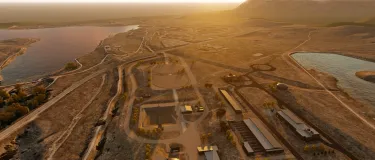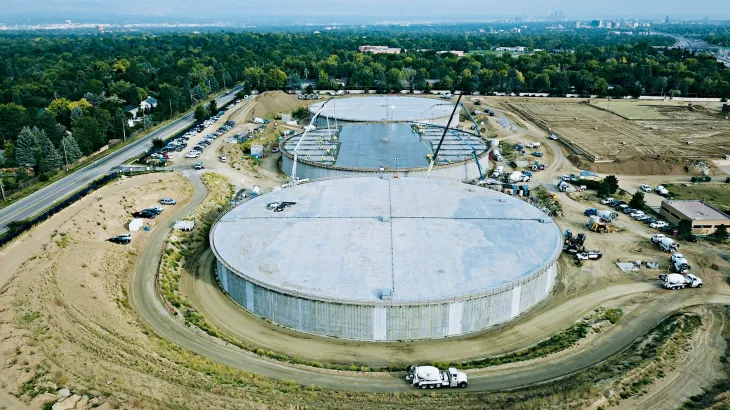Building a More Resilient, Sustainable and Water Secure Future with Internally Cured Concrete
Of the many important climate issues we face today, the increasing scarcity of fresh water is commanding some of the greatest attention and most aggressive efforts. To understand the magnitude of the problem—which is caused in large part by global warming, aridification, and growing population demands—one only needs to look at the drought-stricken American West. Here, the Colorado River is beginning to run dry, and its huge Lake Powell and Lake Mead reservoirs are only one-quarter full. If reservoir levels drop much further, about 10% of the nation’s population faces a realistic threat of not receiving their critical supplies of water.
Perhaps even more disturbing is the fact that across the country an estimated 2.1 trillion gallons of water is lost every year due to leaks in deteriorated infrastructure. Perhaps the single biggest threat to the nation’s water supply is the dire condition of our aging infrastructure, which the American Society of Civil Engineers graded a C-minus in 2021. Moreover, these systems are becoming increasingly vulnerable to extreme weather events. Still, while infrastructure poses an enormous threat, it also offers a significant opportunity to start building back toward securing a more robust fresh water supply.
Investing in America’s Water Future
The $1.2 trillion Infrastructure Investment and Jobs Act will be nothing short of transformational in rebuilding and modernizing our nation’s water infrastructure. This massive investment by the federal government includes $55 billion for upgrading and expanding infrastructure systems and $47 billion for improving resilience to climate change impacts, including droughts. It also dedicates $4 billion to water management and conservation efforts throughout the Colorado River Basin.
With funding from the bipartisan infrastructure bill now rolling out to the states, municipal water providers need to optimize these investments in projects that repair deteriorated, leaking infrastructure or add new capacity. Equally important is to make these systems more sustainable, resilient to changing climate conditions, and operationally efficient to conserve precious and finite water resources.
Resiliency and Sustainability Considerations
If water systems fail to adapt to climate-change shocks or stresses and at the same time do not mitigate emissions during their construction, we will continue to experience serious cascading effects on the environment, economy, water supply, and wellbeing of local communities.
As state and municipal water plans increasingly focus on resiliency, sustainability, and conservation, concrete will play an important role in meeting these priorities with more robust, efficient, and longer-lasting infrastructure with a smaller environmental footprint. Its inherent strength, durability, fire-resistance, and other high-performance properties provide superior protection against all types of natural hazards to ensure critical water systems remain in operation under the harshest of conditions.
In the rebuilding of our aging water systems, Holcim has a wealth of experience and novel high-performance concrete solutions for improving the strength, durability, and longevity of infrastructure, while ultimately reducing costs and water loss. One such innovation is internally cured concrete (ICC).
Curing Concrete from the Inside Out
Maintaining satisfactory and uninterrupted moisture content in freshly placed concrete until cement hydration is complete is important to promoting increased strength, decreased permeability, and a higher quality material. Proper curing of concrete, however, poses a significant challenge in hot, windy, and arid climates because water on the surface can rapidly evaporate—and replenishing that large amount of water loss is problematic in drought-restricted areas. Allowing the concrete surface to dry out excessively will cause the surface to shrink, stress, and crack, resulting in significant water leakage.
Pioneered by Holcim, innovative ICC mixes designed with prewetted expanded shale and clay fines are an ideal, proven solution for improving the quality, performance, and longevity of water infrastructure. These porous lightweight natural pozzolans—used as a partial replacement of normal weight sand in the mix—promote strength gain and the gradual ongoing release of moisture from within the concrete. This curing from the inside out improves cement hydration and crystal growth, increases strength and durability performance, and mitigates early-age cracking due to shrinkage and thermal stresses.
Everything good that cement brings to concrete in terms of performance, internal curing is maximizing with a greater uniformity of water available from the inside out. It also works well with supplementary cementitious materials by using shale and clay to promote strength gain and adherence of the cement paste to the aggregates. For project teams, the bottom line is an innovative high-performance concrete with less cement content, CO2 emissions, and global warming potential.
Improving Durability, Reducing Leakage
Denver is no stranger to the intensifying conditions of climate change nor their impacts on water security. Its desert-like climate is dominated by ever-rising temperatures, low precipitation, and aridification—resulting in intense drought conditions. The future is uncertain, which is why storage is important to managing water supply in Denver, as it has been for centuries elsewhere in Colorado.
Facing rapidly growing water demands within the ever-expanding metro area, Denver Water embarked on a decade-long transformation of its overall storage capacity in 2011 with a new 10-million-gallon water tank in Lone Tree, Colorado. Looking to improve the longevity, performance, and watertightness of the water-containment structure, the project team reached out to the technical experts at Holcim to develop and supply an advanced low-shrinkage, high-performance ICC solution that would reduce shrinkage cracks, enhance durability, and achieve a service life of 100 years.
Due to the dramatic decrease in cracking and leakage observed in the massive Lone Tree tank, Denver Water elected to use the high-performance ICC solution to construct all their future water storage structures. This includes a 7-million-gallon water tank at their Highlands facility, two 10-million-gallon water tanks at their Ashland site, three 15-million-gallon water tanks at their Hillcrest location, and two 10-million-gallon water tanks at their new Northwater Treatment Plant. By capitalizing on the additional performance characteristics of the ICC mixture, the construction contractors working on these projects were able to strip and set their forms more quickly, which compressed and accelerated completion schedules. Visit the Holcim US website for more information on the outstanding results this innovative solution delivered at the Denver Water Northwater Treatment Plant.
The “Go-To” Solution in Colorado
As the demand for water continues to grow while local supplies are threatened by droughts in the arid American West, ICC holds immense promise in building a more durable, longer lasting, and efficient infrastructure future. With Holcim having supplied more than 62,000 cubic yards of this innovative product to water and wastewater projects throughout Colorado over the last decade, it has clearly become this state’s building material of choice for mitigating and adapting to climate change.
To learn more about the ways ICC can offer the best solution for your next water infrastructure project, contact your local sales representative.







